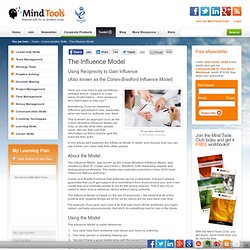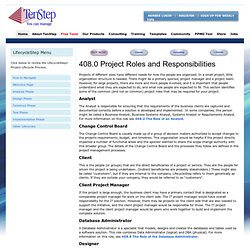

The Influence Model - Communication Skills Training from MindTools. Using Reciprocity to Gain Influence (Also known as the Cohen-Bradford Influence Model) Do you have influence?

© iStockphoto/shironosov Have you ever tried to get something – perhaps advice, support, or a key piece of information – from someone who didn't want to help you? Sometimes, it can be extremely difficult to get people's help, especially when we have no authority over them. This is where an approach such as the Cohen-Bradford Influence Model can help us identify what other people value. In this article we'll examine the Influence Model in detail, and discuss how you can use it when you need help from other people.
About the Model The Influence Model, also known as the Cohen-Bradford Influence Model, was created by Allan R. Cohen and Bradford believe that authority can be problematic. The Influence Model is based on the law of reciprocity – the belief that all of the positive and negative things we do for (or to) others will be paid back over time. Using the Model 1. 2. 3. 4. These are: a. A Free Utility for Project Scheduling and Resource Allocation using Google Spreadsheets. Two important aspects about managing multiple projects with multiple teams are scheduling of the projects & milestones and allocation of resources to these projects.

Over the past few years we have been using a simple Google Spreadsheet based utility which we had developed in-house to schedule projects and to allocate resources for projects. We had earlier released this as Free Software under a GPL license and made this available as free template and over 1000 users are currently using this tool. The utility is available as a free Google Spreadsheet Template at Alternatively you can see a read only copy at The source code for the Google Apps Script part of the application is available at the Zyxware Github account. It is usually possible to do project scheduling and resource allocation manually without any tool when there are only a handful of projects and a handful of team members. Post your comments / questions. Project Roles and Responsibilities. 408.0 Project Roles and Responsibilities Projects of different sizes have different needs for how the people are organized.

In a small project, little organization structure is needed. There might be a primary sponsor, project manager and a project team. However, for large projects, there are more and more people involved, and it is important that people understand what they are expected to do, and what role people are expected to fill. This section identifies some of the common (and not so common) project roles that may be required for your project. Analyst The Analyst is responsible for ensuring that the requirements of the business clients are captured and documented correctly before a solution is developed and implemented. Change Control Board The Change Control Board is usually made up of a group of decision makers authorized to accept changes to the projects requirements, budget, and timelines.
Client Client Project Manager Database Administrator Designer. Project Roles & Responsibilities. 110315Quality=ValueP2.pdf. Measuring the Business Value of a Project. The Value Triple Constraint is an evolution of the Triple Constraint.

It is a framework for measuring the on-going value delivered through projects and for bringing to light the "value left behind". It is pictured below Exhibit 1 - Value Triple Constraint The Value Triple Constraint states: Value delivered is a function of the Scope of the business opportunity and of our Capability to identify, decide and deliver to the opportunity. From a business perspective, a project is aimed at taking an organization from one level of measured performance to a higher level of measured performance.
The Value Triple Constraint: Tracking Four Distinct Phases The Value Triple Constraint (VTC) tracks an opportunity through each of four distinct phases as follows, from last to first: Realization Phase. We tend to focus on the delivery phase. Project Value - Measuring the Outcome at the Project Level The four major components that affect long term value delivery are: Let us explore each of these in turn. Summary. IT project management terms you should know. This glossary will help your IT project teams standardize on frequently used project management terms, from critical path to work breakdown structure to scrum.

Note: This article is based on and an update of Tom Mochal's article, Mini-glossary: Project management terms you should know. Every discipline has its own vocabulary, and project management is no exception. Part of the process of successfully deploying project management in your organization is to standardize the terminology. That way, when one person talks about risks, scope, issues, requirements, and other project management concerns, everyone else knows what he or she is referring to. This glossary contains common terms used in project management and can help start the standardization process in your organization.
Assumption There may be external circumstances or events that must occur for the project to be successful (or that should happen to increase your chances of success). Client / customers Constraints Cost variance Issue Risk. Free Project Management Templates - PMBOK Templates.